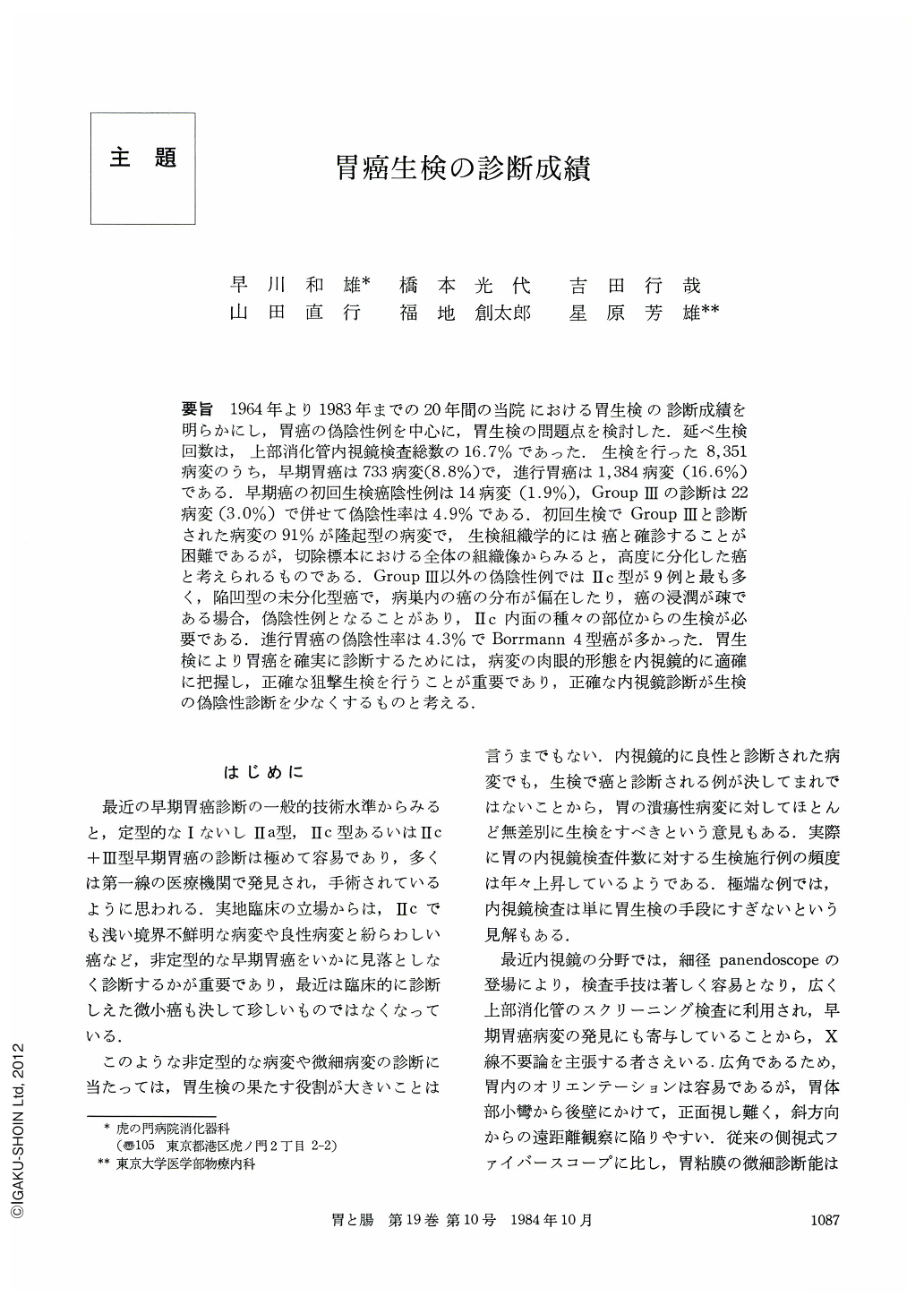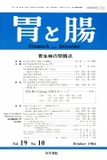Japanese
English
- 有料閲覧
- Abstract 文献概要
- 1ページ目 Look Inside
- サイト内被引用 Cited by
要旨 1964年より1983年までの20年間の当院における胃生検の診断成績を明らかにし,胃癌の偽陰性例を中心に,胃生検の問題点を検討した.延べ生検回数は,上部消化管内視鏡検査総数の16.7%であった.生検を行った8,351病変のうち,早期胃癌は733病変(8.8%)で,進行胃癌は1,384病変(16.6%)である.早期癌の初回生検癌陰性例は14病変(1.9%),GroupⅢの診断は22病変(3.0%)で併せて偽陰性率は4.9%である.初回生検でGroupⅢと診断された病変の91%が隆起型の病変で,生検組織学的には癌と確診することが困難であるが,切除標本における全体の組織像からみると,高度に分化した癌と考えられるものである.GroupⅢ以外の偽陰性例ではⅡc型が9例と最も多く,陥凹型の未分化型癌で,病巣内の癌の分布が偏在したり,癌の浸潤が疎である場合,偽陰性例となることがあり,Ⅱc内面の種々の部位からの生検が必要である.進行胃癌の偽陰性率は4.3%でBorrmann 4型癌が多かった.胃生検により胃癌を確実に診断するためには,病変の肉眼的形態を内視鏡的に適確に把握し,正確な狙撃生検を行うことが重要であり,正確な内視鏡診断が生検の偽陰性診断を少なくするものと考える.
We examined the diagnostic results of the gastric biopsies in the 20 years from 1964 to 1983 in our hospital, and discussed some problems of gastric biopsies with focus on false negative cases of gastric cancer.
Total number of biopsies accounted for 16.7% of the total endoscopic examinations for the upper GI tract. Of the total 8,351 lesions biopsied, 733 lesions (8.8%) were of early gastric cancer and 1,384 lesions (16.6%) were of advanced gastric cancer. Among the cases of early gastric cancer, 14 lesions (1.9%) were negative for cancer at the initial biopsy, 22 lesions. (3.0%) were diagnosed as Group Ⅲ lesions, which means the borderline lesions between benignancy and malignancy according to the diagnostic criteria of gastric carcinoma, and the percentage of false negative cases was 4.9%. Of the Group Ⅲ lesions, 91% was of the elevated type lesions, which were difficult to diagnose as cancer based on the histology of biopsy specimens, but the resected specimen proved to be well differentiated adenocarcinoma histologically.
Of the false negative cases except for Group Ⅲ lesions, early gastric cancer of type Ⅱc was noticed in the highest numbers (9 cases). In the cases of depressed type of undifferentiated adenocarcinoma, the distribution of the cancer cells may be localized inside the lesion, and the cancer cells infiltrated sparsely. There may be possibility for false negative results in such cases and several biopsy specimens must be taken from various portions inside the lesion.
The false negative rate of advanced gastric cancer was 4.3% at the initial biopsy. Borrmann 4 type had the highest negative rate.
In order to accurately diagnose gastric cancer by biopsies, it is important to take hold of the macroscopic appearance of the lesion correctly endoscopically and to perform the aimed biopsy exactly. The accurate endoscopical diagnosis eliminates possibilities of false negative diagnosis by biopsy.

Copyright © 1984, Igaku-Shoin Ltd. All rights reserved.


